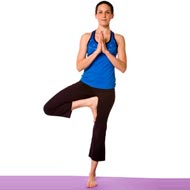- Aromatherapy (36)
- Benefits of Yoga (282)
- Home Remedies (1087)
- massage therapy (9)
- Preventive Therapy (135)
- Running (41)
- Skin Care (15)
- Stress Relief (25)
- Stretching (5)
- walking (33)
- Womens Health (14)
- Yoga Benefits for Pregnant Women (16)
- Yoga Benefits for Students (3)
- Yoga for Children (11)
- Yoga for Holistic Living (37)
- Yoga for Midlife Crisis (3)
- Yoga for Senior Citizens (2)
- Yoga for the Workplace (1)
- Yoga Health Tips (185)
- Yoga Practice during Menstruation (5)
Yoga Is An Excellent Therapy For Deaf People

Yoga can be practiced by everyone, irrespective of age, fitness levels, and physical abilities or disabilities. Anyone who is hearing-impaired or deaf can do all the yoga poses like anyone with perfect hearing. The only difference is that while people with normal hearing can listen to the yoga teacher's instructions clearly, and can follow and understand every step; people who are deaf won't be able to hear what the teacher is saying. This makes the learning process a lot more difficult. It is, therefore, important to find a yoga teacher who is especially trained or qualified to work with deaf students. These teachers will often use sign language; touch, flash cards and other methods to demonstrate every yoga pose and guide their students.
Ways of Teaching Yoga To Deaf People
Yoga teachers who specialize in teaching the deaf, use a combination of methods to teach yoga –
- Speaking and making signs at the same time
- Using sign language to explain what each yoga posture is all about
- Using mime, touch, visual communication, lip reading, gestures, teaching aids as alternatives to verbal communication
- Using lights in the yoga room to give signals to students, especially when they have their eyes closed in postures like the Shavasana (Corpse pose)
- Giving students only a few points at a time to minimize the chances of miscommunication.
- Using DVDs especially created for teaching yoga to deaf people
Inner Yoga For Deaf People
Inner yoga is about feeling every movement and posture from the core. It is believed that the yoga asanas/postures have been developed from our bodies' inner intelligence. Inner yoga is a fusion of yoga postures, spiritual aspects and philosophy that can make the practitioner get in touch with his/her inner core. Inner yoga is often recommended for deaf people.
Yoga Nidra:
You can begin with yoga nidra, which is good for relaxing the mind and body. This is an ancient pose, which aims at higher consciousness and body awareness through meditation.
Pranayama: This is derived from the Sanskrit word, which means, "to lengthen the prana or breath." In yoga, Pranayama is about breath control and helps to relax the body and decrease stress levels.
Benefits of Yoga
There's often a sense of frustration and struggle as deaf children and adults try to learn in a world dominated by speech and verbal communication. Yoga is often recommended as it can help a person to find their inner calm through yoga postures/asanas, breathing techniques and relaxation practices. Yoga is believed to be an excellent therapy for deaf children, who can use yoga to help them cope with negative impressions, frustrations, pent up anger and other charged emotions.
Remember, if you're deaf, you can do all the yoga postures just like everyone else. The only difference is that you will need a qualified teacher who can teach yoga to you using the methods that have been mentioned above.
- RSS Feeds -
- All posts
- All comments
- Deep Tissue Massage Therapy Deep tissue massage therapy is a kind of massage therapy which centers on re...
- Healing Touch Therapy Therapeutic Touch TherapyTherapeutic touch therapy or healing hands ...
- Difference between Palm Therapy and Reflexology Palm therapy and reflexology are both forms of alternative medicine. Both pal...
- Massage for Lupus Lupus or Systemic Lupus Erythematosus (SLE) as it is also known as is an auto...